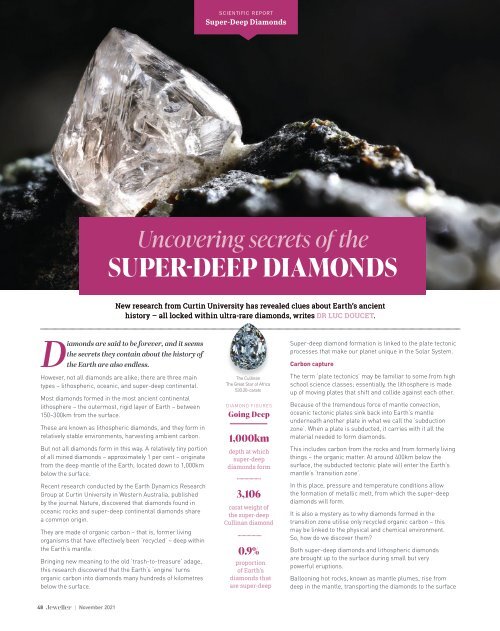Create successful ePaper yourself
Turn your PDF publications into a flip-book with our unique Google optimized e-Paper software.
SCIENTIFIC REPORT<br />
Super-Deep Diamonds<br />
Uncovering secrets of the<br />
SUPER-DEEP DIAMONDS<br />
per-Deep Diamonds<br />
CIENTIFIC REPORT<br />
New research from Curtin University has revealed clues about Earth’s ancient<br />
history – all locked within ultra-rare diamonds, writes DR LUC DOUCET.<br />
Diamonds are said to be forever, and it seems<br />
the secrets they contain about the history of<br />
the Earth are also endless.<br />
However, not all diamonds are alike; there are three main<br />
types – lithospheric, oceanic, and super-deep continental.<br />
Most diamonds formed in the most ancient continental<br />
lithosphere – the outermost, rigid layer of Earth – between<br />
150–300km from the surface.<br />
These are known as lithospheric diamonds, and they form in<br />
relatively stable environments, harvesting ambient carbon.<br />
But not all diamonds form in this way. A relatively tiny portion<br />
of all mined diamonds – approximately 1 per cent – originate<br />
from the deep mantle of the Earth, located down to 1,000km<br />
below the surface.<br />
Recent research conducted by the Earth Dynamics Research<br />
Group at Curtin University in Western Australia, published<br />
by the journal Nature, discovered that diamonds found in<br />
oceanic rocks and super-deep continental diamonds share<br />
a common origin.<br />
They are made of organic carbon – that is, former living<br />
organisms that have effectively been ‘recycled’ – deep within<br />
the Earth’s mantle.<br />
Bringing new meaning to the old ‘trash-to-treasure’ adage,<br />
this research discovered that the Earth’s ‘engine’ turns<br />
organic carbon into diamonds many hundreds of kilometres<br />
below the surface.<br />
The Cullinan<br />
The Great Star of Africa<br />
530.20-carats<br />
DI A MOND FIGURES<br />
Going Deep<br />
1,000km<br />
depth at which<br />
super-deep<br />
diamonds form<br />
3,106<br />
carat weight of<br />
the super-deep<br />
Cullinan diamond<br />
0.9%<br />
proportion<br />
of Earth's<br />
diamonds that<br />
are super-deep<br />
Super-deep diamond formation is linked to the plate tectonic<br />
processes that make our planet unique in the Solar System.<br />
Carbon capture<br />
The term ‘plate tectonics’ may be familiar to some from high<br />
school science classes; essentially, the lithosphere is made<br />
up of moving plates that shift and collide against each other.<br />
Because of the tremendous force of mantle convection,<br />
oceanic tectonic plates sink back into Earth’s mantle<br />
underneath another plate in what we call the ‘subduction<br />
zone’. When a plate is subducted, it carries with it all the<br />
material needed to form diamonds.<br />
This includes carbon from the rocks and from formerly living<br />
things – the organic matter. At around 400km below the<br />
surface, the subducted tectonic plate will enter the Earth’s<br />
mantle’s ‘transition zone’.<br />
In this place, pressure and temperature conditions allow<br />
the formation of metallic melt, from which the super-deep<br />
diamonds will form.<br />
It is also a mystery as to why diamonds formed in the<br />
transition zone utilise only recycled organic carbon – this<br />
may be linked to the physical and chemical environment.<br />
So, how do we discover them?<br />
Both super-deep diamonds and lithospheric diamonds<br />
are brought up to the surface during small but very<br />
powerful eruptions.<br />
Ballooning hot rocks, known as mantle plumes, rise from<br />
deep in the mantle, transporting the diamonds to the surface<br />
48 | <strong>November</strong> <strong>2021</strong>


















